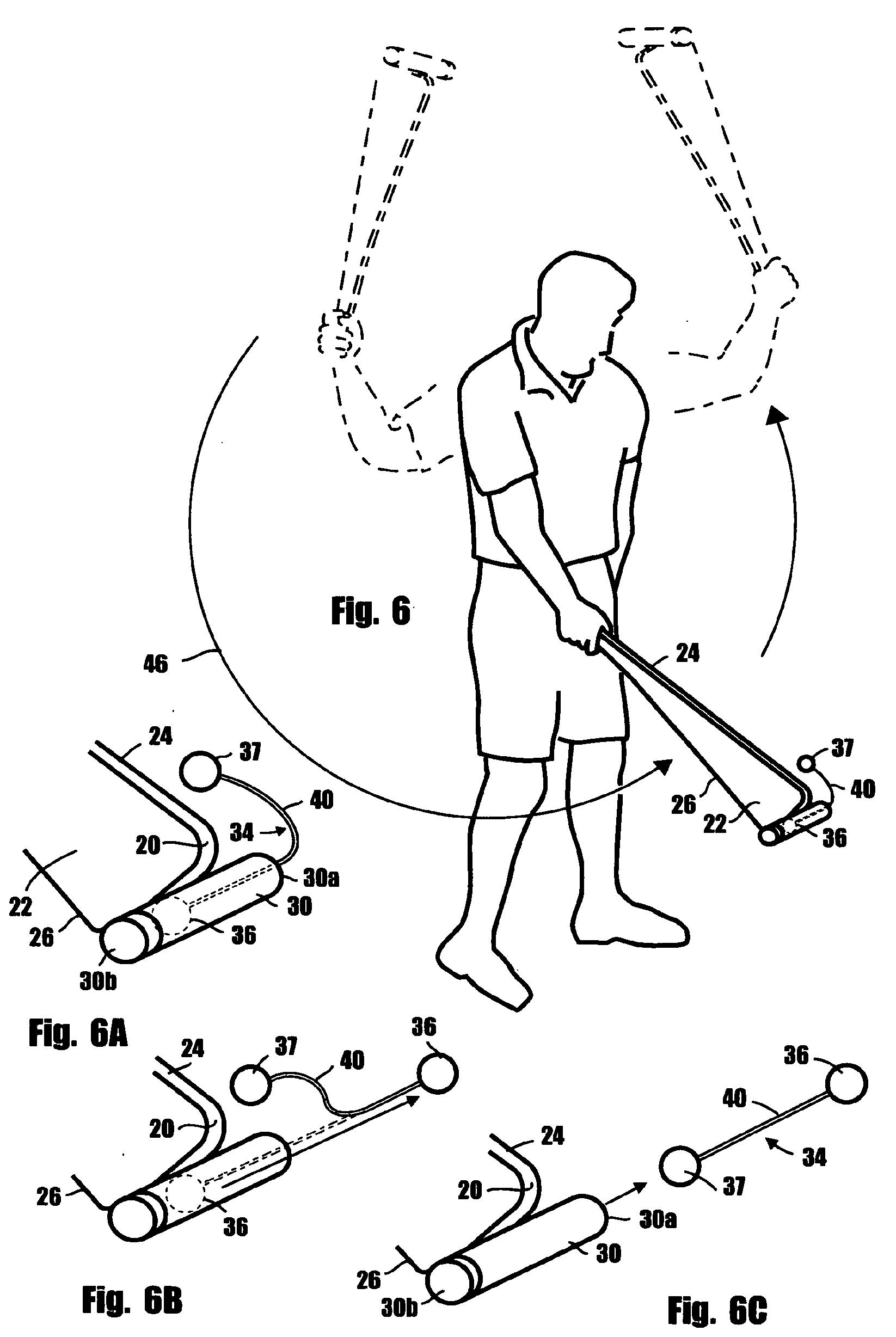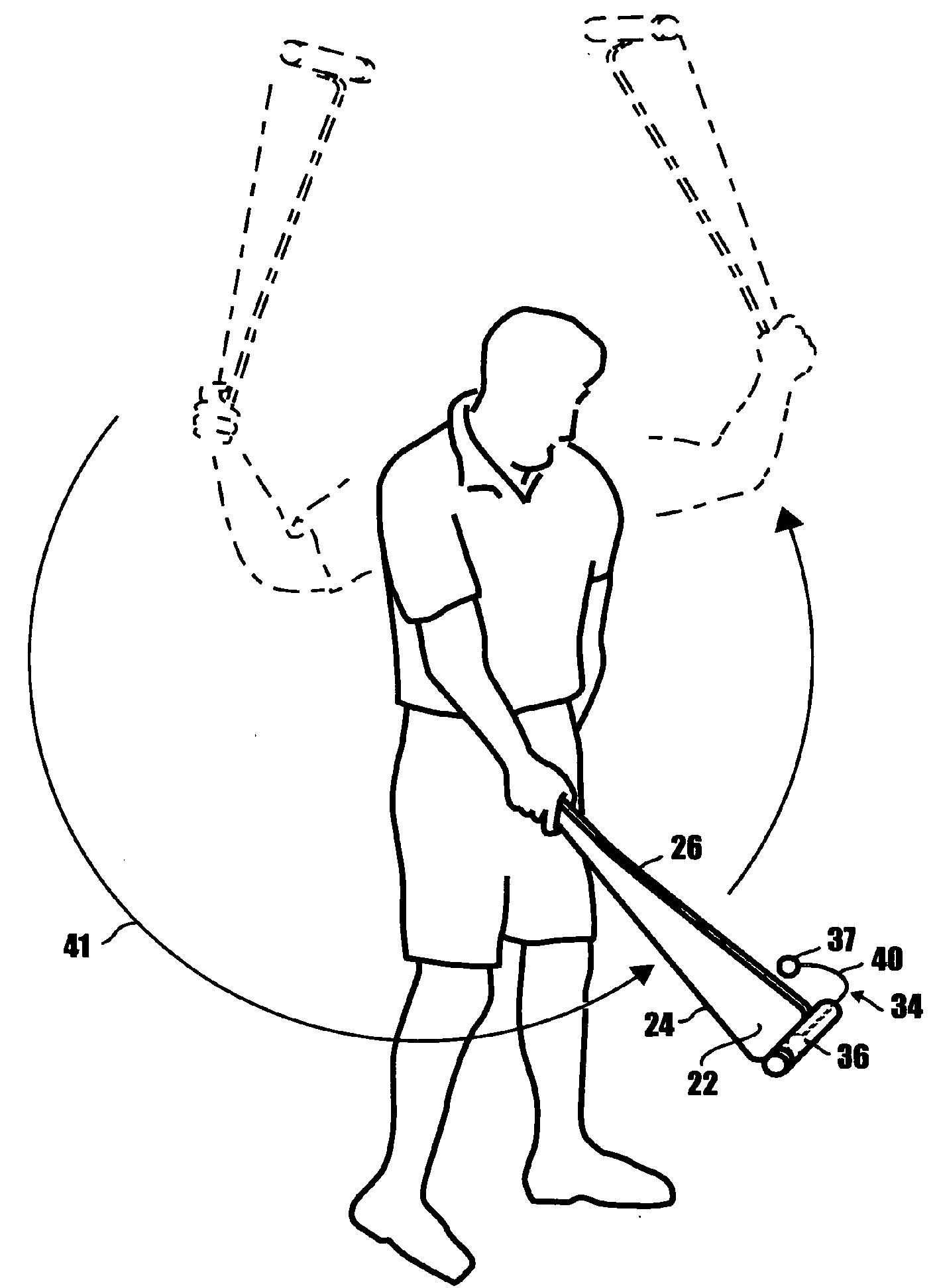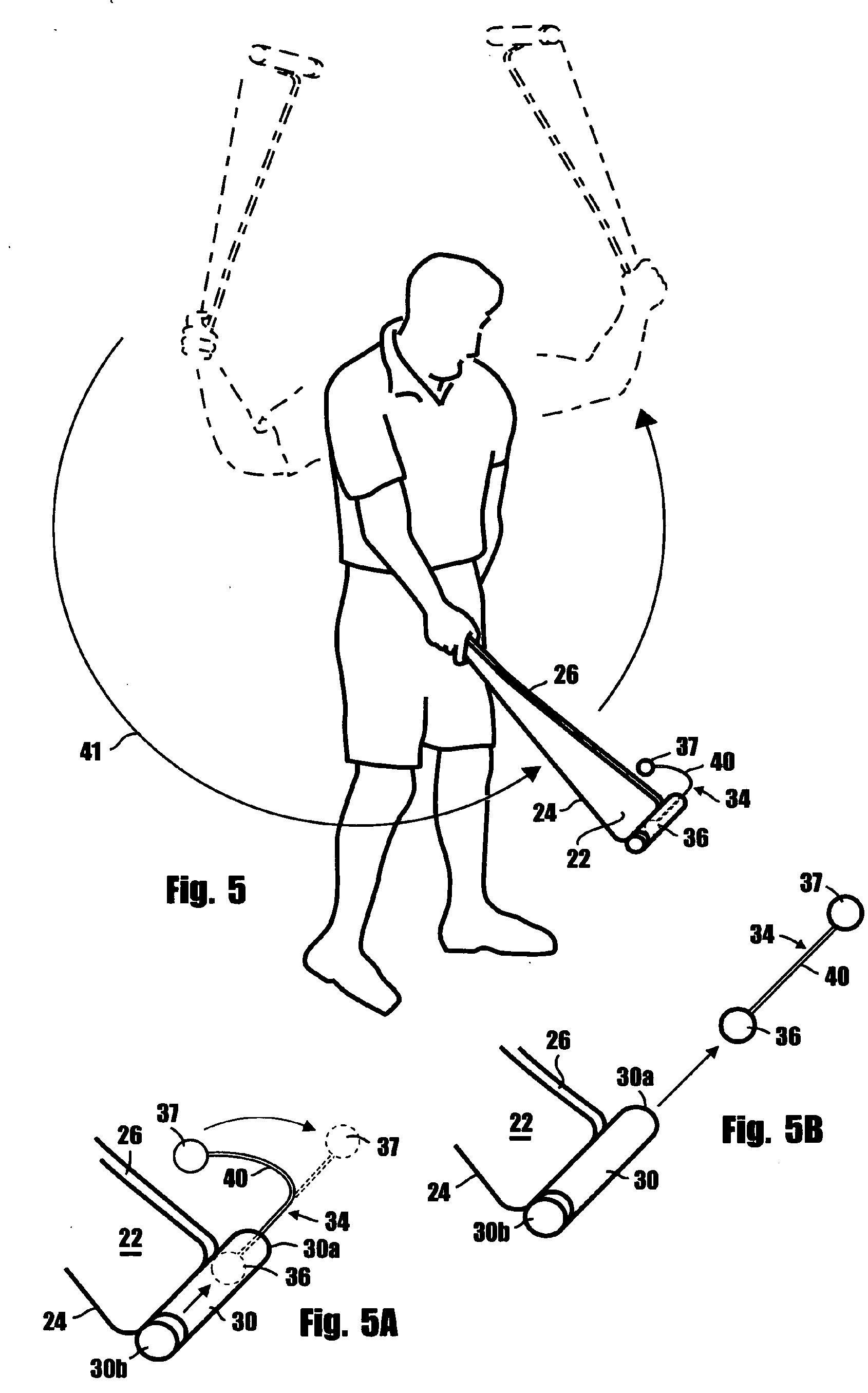I Can’t Decide, Is This Swing Training Invention a Birdie or a Bogey?
An interesting swing training invention is disclosed in a patent application that published this week, but I can’t decide if this is a really good idea or just another toy to collect dust in the basement. The application published as US Pub. No. 20090181785 titled “Golf Swing Training Apparatus” and describes the invention as:
A golf swing training apparatus and method of using same that instructs a trainee in the two optimum golf swings, namely an inward swing and an outward swing. The apparatus of the invention is of a unique configuration that, through the use of a novel practice ball assembly, allows a trainee to positively observe the differences between the inward golf swing and the outward golf swing.
The application explains:
[0004] It is generally agreed that there are two mutually exclusive and equally effective optimum golf swings, namely the so-called “inward” golf swing and the so-called “outward” golf swing. It is also generally agreed that the golf swing embodies two separate applications of geometry, both of which must be properly addressed in an effective golf swing. The first of these, namely “impact geometry” concerns the fact that one must compress the ball on the face of the club head in such a manner that maximum swing force is transferred.
[0005] Accomplishing this without side spin is the ideal, but most accomplished golfers use either a draw spin or a fade spin in carrying out the majority of their shots. The other application of geometry, namely “force controlling geometry” produces the physics that control the transfer of the total swing force to the club head. Most good golfers develop a feel for an effective swing through a trial and error method (“muscle memory”) that is inconsistent at best. Adding to the difficulty with this approach is the fact that there are two diametrically opposed procedures for effectively releasing the club head, each with its own unique feel. Mostly because of this fact, contradictory advice has always plagued the game; more often by being incomplete, rather than totally wrong. The forgoing and various other theories concerning the golf swing have been discussed in numerous books and articles, including books by Ben Hogan and Homer Kelley.
[0006] Ben Hogan in his noted work, “Five Lessons: The Modern Fundamentals of Golf”, likened the swing plane to a large flat pane of glass inclined from the intended line of flight of the ball and generally resting on the shoulders of the trainee. In Hogan’s theory, the glass pane intersected the ground in a line which was coincident with the line of flight. To control club movement, the golfer ideally swung the club head underneath the plane throughout the swing. However, Hogan introduced a slight shift in the plane line in the downswing to account for the apparent motion of the club head outward and away from the golfer from hip height, through impact.
[0007] Homer Kelley, in his well known book “The Golfing Machine” describes the swing plane as a two dimensional geometric structure on which the entire club moves throughout the golf swing. Kelley pictured the swing plane as a flat pane of glass intersecting the ground in a line, with the plane line being identical with the intended initial line of flight of the ball. This plane was described by Kelley as having a dynamically changing inclined angle during the swing, with the entire club remaining on the plane throughout the swing. Kelley mentions in his book that, depending on the number of accumulators used, that is to say, parts of his “power package”, a golf swing can be anything from a simple “one barrel” to a full “four barrel” version.
[0008] The inward and outward swings, which are taught to be recognized by the trainee through the use of the apparatus of the present invention, can be explained in terms of the Kelley concepts as follows: Basically, there are five basic elements of the golf swing; the lower body (hips), the upper body (shoulders), the leading arm, the hands, and the shaft flex. These five elements are released in the sequence listed in the downswing of each swing method. However, each element has the potential to release in either direction, that is, inward or outward. As such, they have the capacity to create torque four times by opposing each other in sequential fashion. It is these four potential segments of torque that actually establish the number of barrels a swing contains and, thereby, its ability to create effortless power.
[0009] In performing the golf swing, each of the five basic elements of the golf swing element is indirectly affected by each of the others. For example, the hips are outward when they are adding to the turning force of the swing through impact and they are inward when they are resisting this force. The shoulders act similarly, but must act in an opposite direction to the hips for a four barrel swing to result. The leading arm is outward when the angle formed by it and the shoulders is increasing (Kelley’s #4 accumulator); and it is inward when this angle is decreasing through impact. The action of the hands and club shaft are similar to the action of the hips and shoulders.
[0010] The importance of understanding and being able to recognize the two swing methods discussed in the preceding paragraphs is highlighted by the fact that, while most touring professionals are inward swingers there are some notable exceptions, including Jack Nicklaus, Greg Norman, Fred Couples and John Daly. Examples of renowned inward swingers include Arnold Palmer, Lee Trevino, Steve Elkington and Nick Faldo.
[0011] Teachers of golf and authors of books and articles on the golf swing almost always fall into one category or the other. For example, Ben Hogan’s “Five Lessons, The Modern Fundamentals of Golf” tends to favor the inward swing, while Leslie King’s “Master Key to Good Golf” tends to favor the outward swing.
OK, but how does it work?
[0031] Turning now to FIG. 5 of the drawings, in using the training apparatus of the invention one of the practice golf balls, such as golf ball 36, is inserted into the open end 30a of the tubular member 30, while the second ball 37 is allowed to remain outside the tubular member on the side of the tube farthest away from the trainee. With the practice golf balls in this position, the trainee grips the hand grip portion member 27 with the right hand and moves the apparatus from the starting position shown in the solid lines in FIG. 5 to an upright position shown by the phantom lines in the left-hand portion of FIG. 5. From this position, the trainee starts the downward swing in the manner illustrated by the arrow 41 of FIG. 5. Due to the novel construction of the apparatus of the invention, as the trainee continues the downward swing in a direction toward the starting position, the trainee will experience the feeling of the inward hand action and the practice ball 37 that is on the outward side of the tubular member will be pulled further away from the trainee in the manner indicated by the phantom lines in FIG. 5A and will drag the practice ball 36 out of the tubular member and toward the target in the manner illustrated in FIG. 5B of the drawings. This result is due largely to the fact that because of the unique configuration of the tapered body portion 22 and because the length of side 26 is somewhat greater than the length of side 24, a centrifugal force (outward shaft flex action) is generated during the swing that causes the practice ball assembly 34 to act in the manner described and in the manner illustrated in FIGS. 5A and 5B drawings to uniquely simulate the feeling of the inward golf swing. If desired, and in order for the practice ball 36 to more freely exit the tubular
member, the tubular member can be rotated in the manner indicated by the phantom lines in FIG. 3 relative to the paddle component into an optimum position.
[0032] In using the training apparatus of the invention to practice the outward golf swing, the paddle component 16 is inverted in the manner illustrated in FIGS. 1A, 2 and 6 of the drawing and the tubular member 30 is rotated approximately 180 degrees relative to the paddle component 16 in the manner illustrated in FIG. 2 of the drawings. This done, one of the practice golf balls, such as golf ball 36, is inserted into the open end 30a of the tubular member 30, while the second ball 37 is allowed to remain outside the tubular member on the side closest to the trainee (see also FIG. 2). With the practice golf balls in this position, the trainee grips the hand grip portion member 27 with the right hand and moves the apparatus from the starting position shown in the solid lines in FIG. 6 to an upright position shown by the phantom lines in the left-hand portion of FIG. 6. From this position, the trainee starts the downward swing in the manner illustrated by the arrow 43 of FIG. 6. Due to the novel construction of the apparatus of the invention, as the trainee continues the swing toward the starting position, the trainee will experience the feeling of the outward golf swing and in this instance the practice ball 36 that is inside the tubular member will be propelled forward in the manner illustrated in FIG. 6B of the drawings and will drag the practice ball 37 toward the target in the manner illustrated in FIG. 6C of the drawings. The lag created by this action simulates inward shaft flex action thereby helping to square the club face at impact. As before, this result is due largely to the fact that because of the unique configuration of the body portion 22, which is now inverted into the position shown in FIG. 6, and because the length of side 26 is somewhat greater than the length of side 24, a centrifugal force is generated during the swing that causes the practice ball assembly 34 to act in the manner described in; as illustrated in FIGS. 6, 6A, 6B and 6C to uniquely simulate the feeling of outward hand action. As before, if desired, and in order for the practice ball 36 to more freely exit the tubular member, the tubular member can be rotated relative to the paddle in the manner illustrated by the phantom lines in FIG. 3 into an optimum position.
Got that? Me neither. Fortunately the inventor has a website that includes a paper explaining the dual swing concept, as well as a video. Check it out!
Could this help your swing?
Dave Dawsey – Tracking Golf Training Product Inventions
PS – click HERE to check out interesting putter posts



